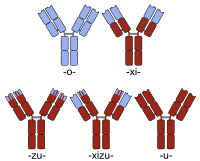- Fusion protein
-
This article is about chimeric fusion proteins. For proteins involved in membrane fusion, see membrane fusion protein.
Fusion proteins or chimeric proteins are proteins created through the joining of two or more genes which originally coded for separate proteins. Translation of this fusion gene results in a single polypeptide with functional properties derived from each of the original proteins. Recombinant fusion proteins are created artificially by recombinant DNA technology for use in biological research or therapeutics. Chimeric mutant proteins occur naturally when a complex mutation, such as a chromosomal translocation, tandem duplication, or retrotransposition creates a novel coding sequence containing parts of the coding sequences from two different genes. Naturally occurring fusion proteins are commonly found in cancer cells, where they may function as oncoproteins. The bcr-abl fusion protein is a well-known example of an oncogenic fusion protein, and is considered to be the primary oncogenic driver of chronic myelogenous leukemia.
Contents
Functions
Some fusion proteins combine whole peptides and therefore contains all functional domains of the original proteins. However, other fusion proteins, especially those that are naturally occurring, combine only portions of coding sequences and therefore do not maintain the original functions of the parental genes that formed them.
Many whole gene fusions are fully functional, and can still act to replace the original peptides. Some, however, experience interactions between the two proteins that can modify their functions. Beyond these effects, some gene fusions may cause regulatory changes that alter when and where these genes act. For partial gene fusions, the shuffling of different active sites and binding domains can potentially result in new proteins with novel functions.
Recombinant technology
A recombinant fusion protein is a protein created through genetic engineering of a fusion gene. This typically involves removing the stop codon from a cDNA sequence coding for the first protein, then appending the cDNA sequence of the second protein in frame through ligation or overlap extension PCR. That DNA sequence will then be expressed by a cell as a single protein. The protein can be engineered to include the full sequence of both original proteins, or only a portion of either.
If the two entities are proteins, often linker (or "spacer") peptides are also added which make it more likely that the proteins fold independently and behave as expected. Especially in the case where the linkers enable protein purification, linkers in protein or peptide fusions are sometimes engineered with cleavage sites for proteases or chemical agents which enable the liberation of the two separate proteins. This technique is often used for identification and purification of proteins, by fusing a GST protein, FLAG peptide, or a hexa-his peptide (6xHis-tag) which can be isolated using affinity chromatography with nickel or cobalt resins. Fusion proteins can also be manufactured with toxins or antibodies attached to them in order to study disease development.
Chimeric protein drugs
The purpose of creating fusion proteins in drug development is to impart properties from each of the "parent" proteins to the resulting chimeric protein. Several chimeric protein drugs are currently available for medical use.
Many chimeric protein drugs are monoclonal antibodies whose specificity for a target molecule was developed using mice and hence were initially "mouse" antibodies. As non-human proteins, mouse antibodies tend to evoke an immune reaction if administered to humans. The chimerization process involves engineering the replacement of segments of the antibody molecule that distinguish it from a human antibody. For example, human constant domains can be introduced, thereby eliminating most of the potentially immunogenic portions of the drug without altering its specificity for the intended therapeutic target. Antibody nomenclature indicates this type of modification by inserting -xi- into the non-proprietary name (e.g. abci-xi-mab). If parts of the variable domains are also replaced by human portions, humanized antibodies are obtained. Although not conceptually distinct from chimeras, this type is indicated using -zu- such as in dacli-zu-mab. See the list of monoclonal antibodies for more examples.
In addition to chimeric and humanized antibodies, there are other pharmaceutical purposes for the creation of chimeric constructs. Etanercept, for example, is a TNFα blocker created through the combination of a tumor necrosis factor receptor (TNFR) with the immunoglobulin G1 Fc segment. TNFR provides specificity for the drug target and the antibody Fc segment is believed to add stability and deliverability of the drug.
Natural occurrence
Naturally occurring fusion genes are most commonly created when a chromosomal translocation replaces the terminal exons of one gene with intact exons from a second gene. This creates a single gene which can be transcribed, spliced, and translated to produce a functional fusion protein. Many important cancer-promoting oncogenes are fusion genes produced in this way.
Examples include:
Antibodies are fusion proteins produced by VDJ recombination.
See also
External links
Categories:- Engineered proteins
Wikimedia Foundation. 2010.

